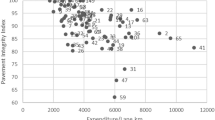Abstract
The article is organized as follows. In Section 2 the arguments for performance auditing in the public sector are reviewed along the lines of the public-choice approach. An international comparison of the functions of supreme auditing institutions (Section 3) reveals that the BelgianRekenhof-Cour des Comptes lags behind, lacking a mandate for performance auditing. In Section 4 the notions of efficiency and effectiveness are clarified. Section S compares the concept of the best-practice frontier with a standard production function. In the public sector one is often confronted with a weak knowledge of the underlying technology. This poses problems of specification for a parametric estimation. Therefore a nonparametric frontier may be recommended. In Section 6 the Farrell method and the free disposal hull are presented. Moreover, when several inputs are transformed into a multiple output (instead of one single homogeneous output), data-envelopment analysis offers a solution (Section 7). These latter methods are also illustrated by an international empirical comparison of the efficiency of public enterprises: postal services in Section 6 and railway companies in Section 7. Some conclusions are reported in the final Section 8.
Similar content being viewed by others
References
Aigner, D., and S. Chu. (1968). “On Estimating the Industry Production Function.”American Economic Review 58(4), 826–839.
Algemene, Rekenkamer. (1989). “An International Comparison of Auditing Authorities.” The Hague. Mimeo.
Atkinson, A., and J. Stiglitz. (1987).Lectures on Public Economics. London: Mc-Graw-Hill.
Beckers, J. (1989). “Interne werking van het parlement: audit als functie van het Rekenhof.” Paper presented at the Politicologencongres, Brussels.
Charnes, A., W. Cooper, and E. Rhodes. (1978). “Measuring Efficiency of Decision Making Units.European Journal of Operations Research 2, 429–444.
—. (1981). “Data Envelopment Analysis: An Approach for Evaluation Program and Managerial Efficiency.”Management Science 27, 668–697.
Christensen, L., D. Jorgenson, and L. Lau. (1973). “Transcendental Logarithmic Production Frontiers.”Review of Economics and Statistics 55(1), 28–45.
Deprins, D., L. Simar, and H. Tulkens. (1984). “Measuring Labor Efficiency in Post Offices.” In M. Marchand, P. Pestieau, and H. Tulkens (eds.),The Performance of Public Enterprises: Concepts and Measurment. Amsterdam: North-Holland.
Farrell, M. (1957). “The Measurement of Productive Efficiency.”Journal of the Royal Statistical Society, 253–290.
Henley, D., C. Holtham, A. Likierman, and J. Perrin. (1989).Public Sector Accounting and Financial Control (3rd ed.). London: Van Nostrand Reinhold.
Leroy, L. (1986). “Data Envelopment Analysis.” Catholic University of Leuven, Department of Applied Economics. Mimeo.
Ludwin, W., and T. Guthrie. (1989). “Assessing Productivity with Data Envelopment Analysis.”Public Productivity Review 4, 361–372.
Mueller, D. (1989).Public Choice II. Cambridge: Cambridge University Press.
Muesen, W., and J. Van den Broeck. (1977). “Efficiency Estimation from Cobb-Douglas Production Functions with Composed Error.”International Economic Review, 18, 435–444.
Musgrave, R., and P. Musgrave. (1984).Public Finance in Theory and Practice (4th ed.). New York: McGraw-Hill.
Palm, A. (1986). “Evolution de la performance de la Répie des Postes Belges par comparaison internationale.” Université de Liegè. Mimeo.
Tulkens, H. (1986). “La performance productive d'un service public: definitions, methodes de mesure et application la Répie des Postes de Belgique.”L'actualité économique: revue d'analyse économique, 62(2), 306–535.
Author information
Authors and Affiliations
Rights and permissions
About this article
Cite this article
Moesen, W.A. The need for performance auditing in the public sector and the best-practice frontier. Eur J Law Econ 1, 263–274 (1994). https://doi.org/10.1007/BF01540700
Issue Date:
DOI: https://doi.org/10.1007/BF01540700




